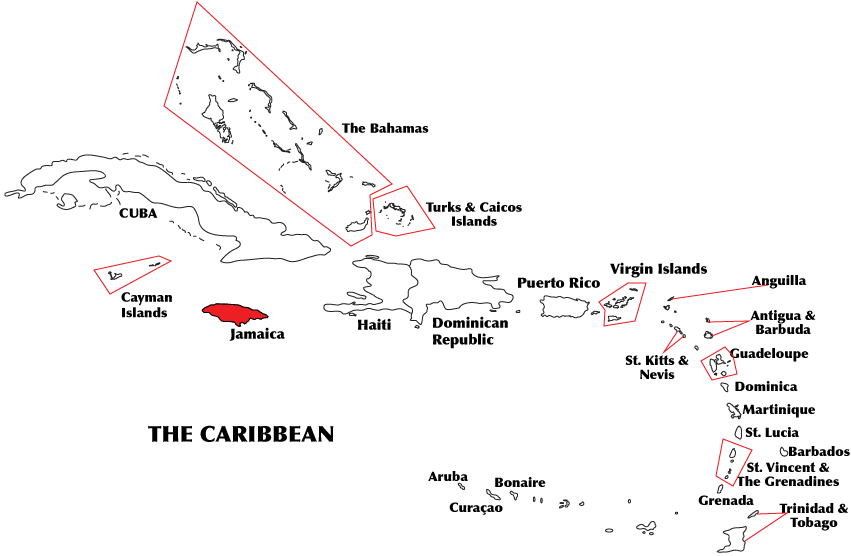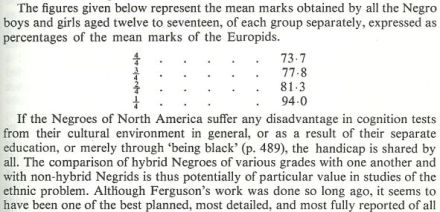In an earlier article, I have shown that the magnitude of sibling correlations among NLSY-ASVAB subtests correlates with the magnitude of g-loadings, but moderately with the magnitude of black-white IQ gaps in those subtests using Jensen’s method of correlated vectors, a possibly imperfect technique in some instances as explained in my previous article. In another post, it has been seen that US blacks having more (self-reported) white ancestry showed a higher IQ level, and that this effect is not mediated by skin color. Here, I will show that the magnitude of the score advantage for blacks with more white ancestry among subtests correlates with the above mentioned variables.
Category: Colorism (Page 1 of 2)
Recently, the GSS released the survey results for the year 2012. And a skin color variable has been included. But rather than using the SDA program, available here, I used the GSS cumulative datafile 1972-2012 for SPSS, available here. This allows more complex analyses to be performed than what is possible with the SDA.
Continue reading
Some things never change
Nearly 100 years ago George Ferguson tested the racial genetic hypothesis of IQ differences and found the following remarkable results, as reported by Baker (1974):
Just a couple of days ago, the awesome Audacious Epigone pointed out that the GSS (2012) contains a color ratings scale. GSS (2012) gives us the following results:
Charles Murray’s 2005 Commentary article, The Inequality Taboo, expressed the idea that the post genomic era has finally brought us a method to resolve the question of genes, race, and intelligence:
To the extent that genes play a role, IQ will vary by racial admixture. In the past, studies that have attempted to test this hypothesis have had no accurate way to measure the degree of admixture, and the results have been accordingly muddy. The recent advances in using genetic markers solve that problem. Take a large sample of racially diverse people, give them a good IQ test, and then use genetic markers to create a variable that no longer classifies people as ‘white’ or ‘black,’ but along a continuum. Analyze the variation in IQ scores according to that continuum. The results would be close to dispositive.
Murray believed such a project would only project scientific legitimacy if the participating researchers had diverse beliefs about the causes of the black-white IQ gap. But when he attempted to assemble the team, with assurances that he himself would find the funding, only the hereditarian researchers wanted to contribute to the project. So it did not happen.
Would the results of such a study really be close to dispositive? Yes and no. Continue reading
Introduction
We have shown, amongst other things, that pre-market measures of IQ substantially statistically explain the association between color and outcomes in the US. This implies that the adult color-outcome differences are substantially caused by IQ differences, rather than vice versa. To investigate this issue further, I have taken a longitudinal approach.
As background, it is well established that the year to year correlation for IQ is mediated by general intelligence on the psychometric level and by shared genes and shared environment on the causal levels. The latter two sources contribute to the longitudinal stability of IQ. Unshared environment, on the other hand, does not. This situation is illustrated in the table immediately below. As is shown, the longitudinal stability of IQ scores for both Blacks and Whites is conditioned by genetic and shared environmental effects. For the Add Health sample, in particular, unshared environment contributes only to longitudinal change.
(From: Beaver, et al. (2013). The genetic and environmental architecture to the stability of IQ: Results from two independent samples of kinship pairs. Intelligence, 41(5), 428-438.)
It follows then that if differences are due to shared genes and shared environment, as we propose, then the IQ-color association should be largely on a factor common across ages. Moreover, IQ at earlier ages should explain some of the IQ-color correlations at a latter ages. Overall, the association between color and IQ should have longitudinal stability. It is, of course, not necessary that it does. If, for example, labor marker color discrimination was leading to outcome differences which were, in turn, leading to IQ difference, the pre-market and post-market color-IQ correlations would not be mediated by a common factor. Likewise, if idiosyncratic individual factors such as peer group influences were conditioning the differences, one would not expect longitudinally stable color associated IQ differences (since such idiosyncratic influences don’t condition longitudinally stable IQ differences).
Introduction. If color-based discrimination becomes more intense at a later age, when darker-skinned individuals face discrimination in the labor market and thus depressing their economic opportunities at every level, for instance, the colorism hypothesis could have argued that IQ measured at earlier ages would not mediate the IQ-outcome relationship measured at a later age because discrimination would have conditioned later success in life.
It has come to my attention that interest in IQ-HBD is on the wane even amongst HBDers and HBDresses. Given this state of affairs, I have decided to compose this post as pithily as possible in hopes that my main points will be delivered before my few readers have fully tuned out:
Continue reading
Note: Our analysis has been updated and extended. Refer also to: Color Differences: Corrections and Further Analysis. Part 1
(or Colorism: Game Over)
Introduction
Following up with Dalliard’s pioneering post on colorism, we looked at the relationship between skin color, cognitive ability, and educational attainment in the full NLSY 97 sample (across all racial and ethnic groups). Our purpose was to test what we term “Strong Colorism”. According to “Strong Colorism”, color discrimination is a unifying explanation for sub-population differences in the US and beyond; it is a generalized phenomenon that can account for pigment related outcome differences. Lest readers suspect that a straw position is being constructed, below is an excerpt from an article, recently published in the journal of Industrial and Organizational Psychology, discussing this model (which the authors take to be established):
Continue reading

IQ and the Wealth of Nations (2002) cites one study for Jamaica (Manley, 1963 ![]() ). The sample size is nearly two thousand school children, and the reported IQ is 72 (p. 209). Lynn’s various updates to that book have included five additional references. However, in another anomaly, the most recent book contains only two references, both with relatively small sample sizes, and omits the large study altogether. The IQ estimate for Jamaica has also been lowered to 67! (Lynn, 2012, p. 403)
). The sample size is nearly two thousand school children, and the reported IQ is 72 (p. 209). Lynn’s various updates to that book have included five additional references. However, in another anomaly, the most recent book contains only two references, both with relatively small sample sizes, and omits the large study altogether. The IQ estimate for Jamaica has also been lowered to 67! (Lynn, 2012, p. 403)
Here I review over 20 intelligence test studies from Jamaica. I find that Lynn’s numbers were not accurately reported, and that IQ is significantly higher in Jamaica than his books have claimed. Continue reading
Previously, we established that skin color and intelligence are correlated in the NLSY97 sample as predicted by hereditarian theory. Continuing this investigation, we looked into how these variables go together within and between African American families in the same sample. In other words, we wanted to know if lighter-skinned individuals tend to be smarter than their darker-skinned siblings just as the average light-skinned black in the general population is smarter than the average dark-skinned black. Continue reading


